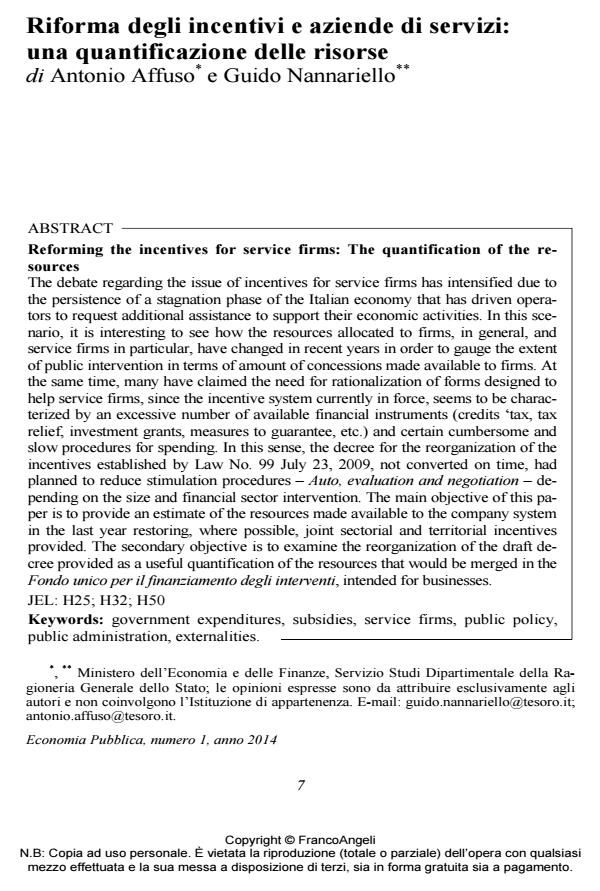Reforming the incentives for service firms: The quantification of the resources
Journal title ECONOMIA PUBBLICA
Author/s Antonio Affuso, Guido Nannariello
Publishing Year 2014 Issue 2014/1
Language Italian Pages 21 P. 7-27 File size 211 KB
DOI 10.3280/EP2014-001002
DOI is like a bar code for intellectual property: to have more infomation
click here
Below, you can see the article first page
If you want to buy this article in PDF format, you can do it, following the instructions to buy download credits

FrancoAngeli is member of Publishers International Linking Association, Inc (PILA), a not-for-profit association which run the CrossRef service enabling links to and from online scholarly content.
The debate regarding the issue of incentives for service firms has intensified due to the persistence of a stagnation phase of the Italian economy that has driven operators to request additional assistance to support their economic activities. In this scenario, it is interesting to see how the resources allocated to firms, in general, and service firms in particular, have changed in recent years in order to gauge the extent of public intervention in terms of amount of concessions made available to firms. At the same time, many have claimed the need for rationalization of forms designed to help service firms, since the incentive system currently in force, seems to be characterized by an excessive number of available financial instruments (credits ‘tax, tax relief, investment grants, measures to guarantee, etc.) and certain cumbersome and slow procedures for spending. In this sense, the decree for the reorganization of the incentives established by Law No. 99 July 23, 2009, not converted on time, had planned to reduce stimulation procedures - Auto, evaluation and negotiation - depending on the size and financial sector intervention. The main objective of this paper is to provide an estimate of the resources made available to the company system in the last year restoring, where possible, joint sectorial and territorial incentives provided. The secondary objective is to examine the reorganization of the draft decree provided as a useful quantification of the resources that would be merged in the Fondo unico per il finanziamento degli interventi, intended for businesses.
Keywords: Government expenditures, subsidies, service firms, public policy, public administration, externalities.
Jel codes: H25; H32; H50
- Bagella M. e Becchetti L. (1998). Gli Effetti di Breve Periodo delle Agevolazioni: il Costo del Debito, l’Offerta di Credito, gli Investimenti e l’Effetto del Ciclo. In: M. Bagella (ed.), Gli Incentivi di Politica Industriale: Presupposti Teorici e Valutazioni Empiriche. Roma: Quaderni di Politica Industriale Mediocredito Centrale, 34-100.
- Barbieri E., Iorio R. e Lubrano-Lavadera G. (2010). Incentivi alla Ricerca & Sviluppo in Italia: una indagine sugli effetti della legge 46/82. L’industria, 2, aprile-giugno, DOI: 10.1430/32497
- Bernini C., Centra M. e Pellegrini G. (2006). Growth and efficiency in subsidized firms, presentato al Workshop The evaluation of Labour Market, Welfare and Firms Incentive Programmes, Venezia, 11-13 maggio.
- Bondonio D. e Greenbaum R.T. (2006). Do Business Investment Incentives Promote Employment in Declining Areas? Evidence from EU Objective-2 Regions. European Urban and Regional Studies, 13, 3, 225-244, DOI: 10.1177/0969776406065432
- Bronzini R. e De Blasio G. (2006). Evaluating the impact of investment incentives: The case of Italy’s Law 488/1992. Journal of Urban Economics, 60, 327-349, DOI: 10.1016/j.bbr.2011.03.031
- Bronzini R., de Blasio G., Pellegrini G. e Scognamiglio A. (2008). La valutazione del credito d’imposta per gli investimenti. Rivista di politica economica, XCVIII, VIIVIII, 79-112.
- Cannari L., D’Aurizio L. e de Blasio G. (2007). The effectiveness of investment subsidies: Evidence from survey data. Rivista italiana degli economisti, XII, 3, 329-46, DOI: 10.1427/27701
- Carlucci C. e Pellegrini G. (2003). Gli effetti della legge 488/92: una valutazione dell’impatto occupazionale sulle imprese agevolate. Rivista Italiana degli Economisti, 2, 267-286, DOI: 10.1427/11472
- Cefis E. e Evangelista R. (2007). La valutazione delle politiche per l’innovazione: un confronto tra Italia e Paesi Bassi, L’industria, XXVII, 2, aprile-giugno, DOI: 10.1430/24639
- De Castris M. e Pellegrini G. (2010). Evaluation of Spatial Effects of Capital Subsidies in the South of Italy. Regional Studies, First published on: 20 October 2010 (iFirst), DOI: 10.1080/00343404.2010.509130
- Faini R. e Schiantarelli F. (1987). Incentives and Investment Decisions: The Effectiveness of Regional Policy. Oxford Economic Papers, Oxford University Press, 39(3), 516-33, September.
- Fotina C. (2011a). Stop alla riforma degli incentivi. Il Sole 24 Ore, 17 febbraio.
- Fotina C. (2011b). Gli aiuti alle imprese divisi in tre strumenti. Il Sole 24 Ore, 18 novembre.
- Legge 23 luglio 2009, n. 99 – Disposizioni per lo sviluppo e l’internazionalizzazione delle imprese, nonché in materia di energia, GU n. 176 del 31-7-2009 – Supplemento Ordinario n. 136.
- Legge 31 dicembre 2009, n. 196, Legge di contabilità e finanza pubblica, G.U. n. 303 del 31 dicembre 2009.
- Ministero dello Sviluppo Economico (2009), Relazione sugli interventi a sostegno delle attività economiche e produttive.
- Ragioneria Generale dello Stato, Pareri n. 9068/2010, n.9765/2011 e n.9772/2011. Schema di decreto legislativo recante attuazione della delega di cui all’articolo 3 della legge 23 luglio 2009, n. 99.
Antonio Affuso, Guido Nannariello, Riforma degli incentivi e aziende di servizi: una quantificazione delle risorse in "ECONOMIA PUBBLICA " 1/2014, pp 7-27, DOI: 10.3280/EP2014-001002